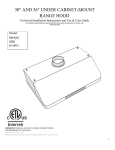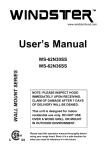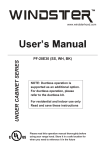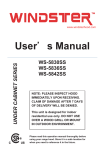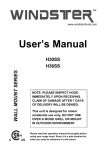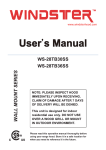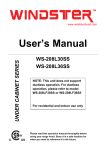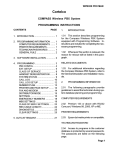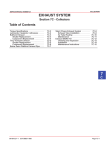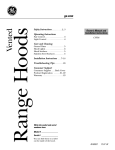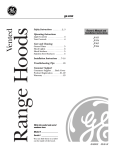Download UNDER CABINET RANGE HOOD
Transcript
UNDER CABINET RANGE HOOD Universal Installation Instructions and Use & Care Guide For questions about features, operation/performance parts, accessories or service, call: 1-626-453-0550 Model: Y01 W01 IMPORTANT: READ AND SAVE THESE INSTRUCTIONS. FOR RESIDENTIAL USE ONLY. Revised September 2014 Disclaimer: Item purchased may be slightly different from the manual. 1 TABLE OF CONTENTS RANGE HOOD SAFETY ....................................................................2 INSTALLATION REQUIREMENTS ...................................................4 Tools and Parts Requirements ...................................................4 Location Requirements .............................................................4 Installation Dimensions ............................................................5 Ventilation Requirements .........................................................6 Electrical Requirements ............................................................7 INSTALLATION INSTRUCTIONS ..................................................8 Prepare Location ......................................................................8 Connect Vent System ..............................................................10 Complete Installation ..............................................................11 Electrical Connection ……………………………………………..12 RANGE HOOD USE .........................................................................13 Range Hood Controls ..............................................................14 RANGE HOOD CARE ......................................................................15 Cleaning .................................................................................15 Replacement ...........................................................................16 TROUBLE SHOOTING ...................................................................17 WARRENTY & SERVICES .............................................................19 RANGE HOOD SAFETY Your safety and the safety of others are very important. We have provided many important safety messages in this manual and on your appliance. Always read and obey all safety messages. This is the safety alert symbol. This symbol alerts you to potential hazards that can kill or hurt you and others. All safety messages will follow the safety alert symbol and either the word “DANGER” or “WARNING.” These words mean: DANGER WARNING You can be killed or seriously injured if you don't immediately follow instructions. You can be killed or seriously injured if you don't follow instructions. 2 IMPORTANT SAFETY INSTRUCTIONS WARNING: TO REDUCE THE RISK OF FIRE, ELECTRIC SHOCK, OR INJURY TO PERSONS, READ THE FOLLOWING: ■ Use this unit only in the manner intended by the manufacturer. If you have questions, please contact the manufacturer. ■ Before servicing or cleaning the unit, switch the power off and lock the service panel. This will prevent the power from accidentally turning on. If the service panel does not lock, secure a warning label, such as a tag, to the service panel. ■ Installation work and electrical wiring must be done by a qualified professional(s) in accordance with all applicable codes, standards, and fire-rated constructions. ■ Do not operate any fans with a damaged cord or plug. Discard the fan or return to an authorized service facility for further examination and/or repair. ■ To prevent back draft, sufficient air is needed for proper combustion. Gas from fuel burning equipment needs to exhaust through the flue (chimney). Follow the heating equipment manufacturer's guideline and safety standards such as those published by the National Fire Protection Association (NFPA), the American Society for Heating, Refrigeration and Air Conditioning Engineers (ASHRAE), and the local code authorities. ■ When cutting or drilling into walls or ceilings; be aware of electrical wires, piping, and other utilities. ■ Ducted fans must always be vented outdoors. CAUTION: For general ventilation use only. Do not use to exhaust hazardous or explosive materials and vapors. CAUTION: To reduce the risk of fire and to properly exhaust air, be sure to duct air outside - DO NOT vent exhaust air into attics, crawl spaces, garages, or within walls and ceilings. WARNING: TO REDUCE THE RISK OF A RANGE TOP GREASE FIRE, READ THE FOLLOWING: ■ Never leave surface units unattended at high settings. Boil-over can cause smoke and grease to spill over that may ignite. Heat oils slowly on low or medium settings. ■ Always turn the hood ON when cooking at high heat or when flambéing food (i.e. Crepes Suzette, Cherries Jubilee, Peppercorn Beef Flambé). ■ Clean ventilation fans frequently. Grease should not be allowed to accumulate on fan or filter. ■ Use proper pan size. Always use cookware appropriate for the size of the surface element. WARNING: TO REDUCE THE RISK OF INJURY. IN THE EVENT OF A RANGE TOP GREASE FIRE, READ THE FOLLOWING: ■ SMOTHER FLAMES with a close fitting lid, cookie sheet, or metal tray, then turn off the burner. BE CAREFUL TO PREVENT BURNS. If the flames do not go out immediately, EVACUATE AND CALL THE FIRE DEPARTMENT. ■ NEVER PICK UP A FLAMING PAN - you may be burned. ■ DO NOT USE WATER, including wet dishcloths or towels a violent steam explosion will result. ■ Use an extinguisher ONLY if: – You know you have a class ABC extinguisher, and you already know how to operate it. – The fire is small and contained in the area where it started. – The fire department is being called. – You can fight the fire with your back to an exit. Based on "Kitchen Fire Safety Tips" published by NFPA. ■ WARNING: To reduce the risk of fire or electrical shock, do not use this fan with any solid-state speed control device. 3 INSTALLATION REQUIREMENT TOOLS AND PARTS REQUIREMENTS Electrical drill or ratchet driver 1/2” drill bit for drilling pilot holes 1 ¼” drill bit for drilling electrical wiring access hole. Screwdrivers: Philips & Straight blade Pliers Tape measure or ruler and pencil Electrical supplies for wiring Aluminum foils tape and/or duct tape Hammer Jigsaw or saber saw Stud finder Parts Supplied Body 1 Pc Installation manual 1 Set Metal filter 1-4 Pcs Air outlet 1 Set Exhaust pipe 1 Pc Hardware 1 Set LOCATION REQUIREMENTS IMPORTANT: Observe all governing codes and ordinances. Have a qualified technician install the range hood. It is the installer’s responsibility to comply with installation clearances specified on the model/serial rating plate. Canopy hood's location should be away from strong draft areas, such as windows, doors, and strong heating vents. Cabinet opening dimensions that are shown must be used. Given dimensions provide minimum clearance. Disclaimer: Screws many vary from model to model. 4 INSTALLATION DIMENSIONS A. B. C. D. Countertop height Hood height from ceiling to bottom of the range hood filter surface: D-A-C=B 29” (73.66 cm) min. from cooking surface, suggested 31” (78.74 cm) max. Ceiling height 5 VENTILATION REQUIREMENTS ■ Range hoods must be ventilated to the outdoors ■ Do not ventilate the range hood into an attic or other enclosed areas. ■ Do not use 4" (10.2 cm) laundry-type wall caps. ■ The length of the range hood and the number of elbows should be kept to a minimum to provide maximum performance. For the most efficient and quiet operation ■ Use no more than three 90°elbows. ■ Make sure there is a minimum of 24" (61 cm) of straight duct between the elbows if more than one elbow is used. ■ Do not install two elbows together. ■ Use clamps to seal all joints in the vent system. ■ The vent system must have a damper. If the roof or wall cap has a damper, do not use the damper supplied with the range hood. ■ Use caulking to seal exterior walls or roof openings around the cap. ■ The size of the vents should be uniform. Venting Method This canopy hood is factory set for through the roof or wall. A 6" (15.2 cm) round vent system is needed for installation. The hood exhaust opening is 6" (15.2 cm) round. To vent through a wall, a 90°elbow is needed. If exhaust ducting with a diameter of less than 5.91” (150 mm) or if flat ducting is used, the noise level of the range hood will increase and extraction will be less efficient. Rear Discharge A 90°elbow may be installed immediately above the hood. Cold Weather Installations An additional back draft damper should be installed to minimize backward cold air flow. A thermal break should be installed to minimize conduction of outside temperatures as part of the vent system. The damper should be on the cold air side of the thermal break. The break should be as close as possible to where the vent system enters the heated portion of the house. Makeup Air Local building codes may require the use of makeup air systems, when using ventilation systems greater than specified CFM of air movement. The specified CFM varies from state to state. Consult your HVAC professional for specific requirements in your area. 6 Calculating Vent System Length To calculate the length of the system you need, add the equivalent feet (meters) for all vent pieces used in the system. ELECTRICAL REQIUREMENTS Observe all governing codes and ordinances. Ensure that the electrical installation is adequate and in conformance with the National Electrical Codes, ANSI/NFPA 70 (latest edition), or CSA Standards C22.1-94, Canadian Electrical Code, Part 1 and C22.2 No. 0-M91 (latest edition), all local codes, and ordinances. If codes permit and a separate ground wire is used, it is recommended that a qualified electrician determine that the ground path is adequate. A copy of the above code standards can be obtained from: National Fire Protection Association 1 Batterymarch Park Quincy, MA 02169-7471 CSA International 8501 East Pleasant Valley Road Cleveland, OH 44131-5575 ■ A 120 volt, 60 Hz., AC only, 15-amp, fused electrical circuit is required. ■ If the house has aluminum wiring, follow the procedure below: 1. Connect a section of solid copper wire to the pigtail leads. 2. Connect the aluminum wiring to the copper wire using special connectors and/or tools designed and UL listed for joining copper to aluminum. Follow the electrical connector manufacturer's recommended procedure. Aluminum/copper connection must conform to local codes and industry accepted wiring practices. ■ Wire sizes and connections must conform to the rating of the appliance as specified on the model/serial rating plate. The model/serial plate is located behind the filter on the rear wall of the range hood. ■ Wire sizes must conform to the requirements of the National Electrical Code, ANSI/NFPA 70 (latest edition), or CSA Standards C22. 1-94, Canadian Electrical Code, Part 1 and C22.2 No. 0-M91 (latest edition) and all local codes and ordinances. 7 INSTALLATION INSTRUCTIONS PREPARING THE LOCATION ■ It is recommended for the vent system to be installed before hood is installed. ■ Before making cutouts, make sure there is proper clearance from the range hood to the cook top. ■ Check your cabinet’s height and the hood height available for your ceiling before selecting your hood. 1. Disconnect the power. 2. Determine which venting method to use: roof, wall, or back. RANGE HOOD MOUNTING SCREWS INSTALLATION 1. Determine and mark the centerline on the cabinet where the range hood will be installed. 2. Select a mounting height between a minimum of 27” (68.6cm) ) for an electric cooking surface, a minimum of 27” (68.6cm) for a gas cooking surface, and a suggested maximum of 36” (91.4cm) above the cooking range to the bottom of the range hood. Mark a reference line on the wall. a. IMPORTANT: All screws must be installed into wood. If there is no wood to screw into, additional wall framing supports may be required. 3. Drill ³⁄₁ ₆ " (4.8 mm) pilot holes at all locations where screws are being installed into wood. 4. Install 4 M5 x 45 mounting screws under the cabinet and 4 M5 X12 screws in the inner sides of the cabinet. 8 Air Flow Flapper Preparation 5. Mark the flappers location under the cabinet. 6. Cut out a rectangle a little bit larger than the air flow flapper under the cabinet. Also, cut out a circle where the white, green, and black wires would be. Complete Preparation 1. Determine and make all necessary cuts in the wall for the vent system. Install the vent system before installing the hood. See Page 6 “Ventilation Requirements” Section. 2. Determine the required height for the home power supply cable and drill a 1¼" (3.2 cm) hole at this location. 3. Run the home power supply cable according to the National Electrical Code or CSA Standards and local codes and ordinances. There must be enough conduits (½") and wires from the fuse box (circuit breaker) to make the connection in the hood’s electrical terminal box. a. 4. IMPORTANT: Do not reconnect power until installation is complete. Use caulking sealant to seal all openings. 9 STEP 1: CONNECTING VENT SYSTEM Air Flow Flapper Installation 1. Install the non-return air flap on top of hood with M5 X 8 screws (Part B). 2. Remove the tape from the air flow flappers. (Part C) 10 STEP 2: MOUNTING THE RANGE HOOD 1. After preparing the location, use two or more people, hang the range hood on the 8 mounting screws (Part A), installed during preparations (Look at page 8), through the mounting slots on the top of hood (Part B1). Excessive Weight Hazard Use two or more people to move and install range hood. Failure to do so can result in back or other injury. 2. Level the range hood and tighten inner M5 X 45 mounting screws (Part B2). 3. Tighten the 4 M5 X 12 screws after (Part C). 11 STEP 3: ELECTRICAL CONNECTION 1. Connect the three prong cable (not included) to the existing cable on the range hood. 2. Connect the White to White, Black to black, and Green ground to green ground by either a solder or with a connection piece. DO NOT FORGET TO GROUND THE CONNECTION SAFETY WARNING: Risk of electrical shock. This range hood must be properly grounded. Make sure this is done by a qualified electrician in accordance with all national and local electrical codes. Before connecting the wires, switch the power off at the service panel and lock the service panel to prevent power from being switched on accidentally. 12 RANGE HOOD USE The range hood is designed to remove smoke, vapors, and odors. For best results, start the hood before cooking. After, the cooking process is complete, allow the range hood to run for several minutes to completely clear all the smoke and odors from the kitchen. A. Return Air flapper B. LED/Halogen lights C. Control Panel D. Grease Filter 13 RANGE HOOD CONTROLS Operating the lights The On/Off light button controls both lights. Press once for “ON” and again for “OFF”. Operating the blower The “Speed” button turns the fan on and controls the fan speed and sound level for quiet operation. The speed can be changed anytime during the fan operation by pressing the desired blower speed button. The “OFF” button turns the fan off. Disclaimer: Control panel may vary from model to model; models may not have these controls at all. This is a general type of control panel. 14 RANGE HOOD CARE Cleaning IMPORTANT: Clean the hood and grease filters frequently according to the following instructions. Replace panel filters before operating hood. Exterior Surfaces To avoid damage to the exterior surface, do not use steel wool or soap-filled scouring pads. Always wipe dry to avoid water marks. Cleaning Method Use liquid detergent soap and water, or all-purpose cleanser. Wipe with damp soft cloth or non-abrasive sponge, then rinse with clean water and wipe dry. Grease Filter and Baffle Filter 1. Remove the filter by pulling the spring release handle and then pulling down the filter. 2. Wash metal filters as needed in dishwasher or hot detergent solution. 3. Reinstall the filter by making sure the spring release handles are toward the front. Insert aluminum filter into upper track. 4. Push the spring release handle. 5. Push up on metal filter and release handle to latch into place. 15 Replacing the LED/Halogen light Turn off the range hood and allow the LED/Halogen to cool. To avoid damage or decreasing the life of the new bulb, do not touch bulb with bare fingers. Replace bulb using tissue or wearing cotton gloves to handle bulb. If new LED/Halogen light does not operate, make sure the lamps are inserted correctly before calling service. For replacement please visit our website www.shoprangehoods.com . 16 TROUBLE SHOOTING Potential Effect of Failure Lamp does not turn ON FAN does not work Potential Cause(s) Recommended Action(s) Electronic Control does not work. Due to Over Voltage a) Pressing any key the LCD lights up and icons are in place? Yes, Proceed with the following diagnostic sequence No, Replace the control and user interface. Non functional lamp 1) Remove the lamp. 2) Verify the lamp to be non functional reviewing that the filament is not burned and be in correct place. 3) Replace if needed. During the hood cleaning, the motor connector has been loose and a false contact in the main harness is performed. 1) Open the control box removing the screws. 2) Remove power supply from the hood. 3) Verify that the connector coming from the motor is well connected to the connector mounted in the plastic verifying that the locking system in the connectors is well locked. 4) If the connectors are not well connected: - Hold and press main connectors attached in the white plastic. - Push inwards the motor/lamp connectors until the locking system on connectors is well attached. 5) Connect hood to power supply and verify. Electronic Control does not work. Due to Over Voltage a) Pressing any key the LCD lights up and Icons are in place? Yes, Proceed with the following diagnostic sequence No, Replace the control and user interface. During the hood cleaning, the motor connector has been loose and a false contact in the main harness is performed. 1) Open the control box removing the screws. 2) Remove power supply from the hood. 3) Verify that the connector coming from the motor is well connected to the connector mounted in the plastic and that the locking system in the connectors is well locked. 4) If the connectors are not well connected: - Hold and press main connectors attached 17 in the white plastic. - Push inwards the motor/lamp connectors until the locking system on connectors is well attached. 5) Connect hood to power supply and verify. The blower is too noisy Filters are dirty 1) Verify that the grease and/or charcoal filters are clean. 2) If they are not clean change charcoal filter, or wash grease filter and verify. False contact in the connectors During the hood cleaning, the motor connector has been loose and a false contact in the main harness is performed. 1) Open the control box removing the screws. 2) Remove power supply from the hood. 3) Verify that the connector coming from the motor is well connected to the connector mounted in the plastic and that the locking system in the connectors is well locked. 4) If the connectors are not well connected: - Hold and press main connectors attached in the white plastic. - Push inwards the motor/lamp connectors until the locking system on connectors is well attached. 5) Connect hood to power supply and verify. The hood and or the lamp does not work A terminal or connector is loose 1) Open the control box removing the 6 screws. 2) Remove power supply from the hood. 3) Verify that the connector coming from the motor is well connected to the connector mounted in the plastic and that the locking system in the connectors is well locked. 4) If the connectors are not well connected: - Hold and press main connectors attached in the white plastic. - Push inwards the motor/lamp connectors until the locking system on connectors is well attached. 5) Connect hood to power supply and verify. If your problem is not listed in the trouble shooting above please contact [email protected] 18 SHOPRANGEHOODS.COM MAJOR APPLIANCE WARRANTY LIMITED WARRANTY For three year from the date of purchase, when this major appliance is operated and maintained according to instructions attached to or furnished with the product, Www.shoprangehoods.com will pay for Factory Specified Parts. This limited warranty is valid only in the United States or Canada and applies only when the major appliance is used in the country in which it was purchased. Outside the 50 United States and Canada, this limited warranty does not apply. Proof of original purchase date is required to obtain service under this limited warranty. ITEMS EXCLUDED FROM WARRANTY This limited warranty does not cover: 1. Service calls to correct the installation of your major appliance, to instruct you on how to use your major appliance, to replace or repair house fuses, or to correct house wiring or plumbing. 2. Service calls to repair or replace appliance light bulbs, air filters or water filters. Consumable parts are excluded from warranty coverage. 3. Repairs when your major appliance is used for other than normal, single-family household use or when it is used in a manner that is contrary to published user or operator instructions and/or installation instructions. 4. Damage resulting from accident, alteration, misuse, abuse, fire, flood, acts of God, improper installation, installation not in accordance with electrical or plumbing codes, or use of consumables or cleaning products not approved by Www.shoprangehoods.com. 5. Cosmetic damage, including scratches, dents, chips or other damage to the finish of your major appliance, unless such damage results from defects in materials or workmanship and is reported to Www.shoprangehoods.com within 30 days from the date of purchase. 6. Any food loss due to refrigerator or freezer product failures. 7. Costs associated with the removal from your home of your major appliance for repairs. This major appliance is designed to be repaired in the home and only in-home service is covered by this warranty. 8. Repairs to parts or systems resulting from unauthorized modifications made to the appliance. 9. The removal and reinstallation of your major appliance if it is installed in an inaccessible location or is not installed in accordance with published installation instructions. 10. Major appliances with original model/serial numbers that have been removed, altered or cannot be easily determined. This warranty is void if the factory applied serial number has been altered or removed from your major appliance. The cost of repair or replacement under these excluded circumstances shall be borne by the customer. DISCLAIMER OF IMPLIED WARRANTIES; LIMITATION OF REMEDIES CUSTOMER'S SOLE AND EXCLUSIVE REMEDY UNDER THIS LIMITED WARRANTY SHALL BE PRODUCT REPAIR AS PROVIDED HEREIN. IMPLIED WARRANTIES, INCLUDING WARRANTIES OF MERCHANTABILITY OR FITNESS FOR A PARTICULAR PURPOSE, ARE LIMITED TO ONE YEAR OR THE SHORTEST PERIOD ALLOWED BY LAW. WWW.SHOPRANGEHOODS.COM SHALL NOT BE LIABLE FOR INCIDENTAL OR CONSEQUENTIAL DAMAGES. SOME STATES AND PROVINCES DO NOT ALLOW THE EXCLU-SION OR LIMITATION OF INCIDENTAL OR CONSEQUENTIAL DAMAGES, OR LIMITATIONS ON THE DURATION OF IMPLIED WARRANTIES OF MERCHANTABILITY OR FITNESS, SO THESE EXCLU-SIONS OR LIMITATIONS MAY NOT APPLY TO YOU. THIS WARRANTY GIVES YOU SPECIFIC LEGAL RIGHTS, AND YOU MAY ALSO HAVE OTHER RIGHTS WHICH VARY FROM STATE TO STATE OR PROVINCE TO PROVINCE. If you need service, first see the “Troubleshooting” section of the User Manual. After checking “Troubleshooting,” you may find additional help by calling Www.shoprangehoods.com. In the U.S.A., call 1626-453-0550 or visit our website at www.ShopRangeHoods.com .Keep this book and your sales slip together for future reference. You must provide proof of purchase or installation date for in-warranty service. Write down the following information about your major appliance to better help you obtain assistance or service if you ever need it. You will need to know your complete model number and serial number. You can find this information on the model and serial number label located on the product. Dealer name____________________________________________________ Address _______________________________________________________ Phone number__________________________________________________ Model number __________________________________________________ Serial number __________________________________________________ Purchase date __________________________________________________ 19



















